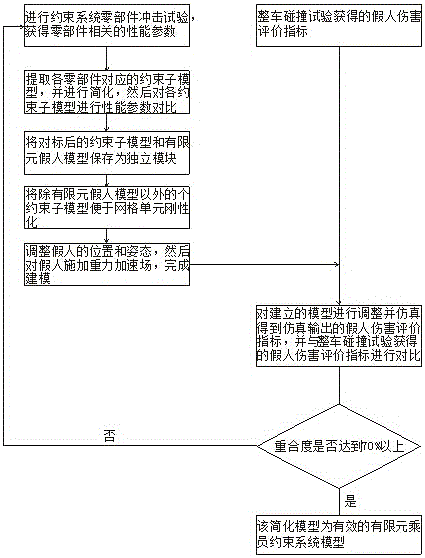Finite element passenger restraint system model based on modularized modeling and modeling method thereof
A technology of occupant constraints and system models, applied in design optimization/simulation, special data processing applications, instruments, etc., can solve problems that affect research progress, poor flexibility, and low calculation efficiency, achieve extensive engineering application value, and improve optimization matching Efficiency, the effect of shortening the modeling time
- Summary
- Abstract
- Description
- Claims
- Application Information
AI Technical Summary
Problems solved by technology
Method used
Image
Examples
Embodiment
[0023] Embodiment: a finite element occupant restraint system model based on modular modeling, including the following constraint sub-models: seat belt model, airbag model, seat model, instrument panel model, steering wheel model, finite element dummy model, vehicle The floor model and the windshield model, among them, the models that have a greater impact on occupant injuries have undergone relevant performance tests to improve the reliability of each module. The performance tests include: seat belt tensile test, static airbag deployment test, seat loading dynamic test, instrument panel dynamic impact test, steering wheel static stiffness test, steering column static crushing and dynamic crushing test, TANK test and drop weight test.
[0024] see figure 1 , figure 2 , a modeling method of the above-mentioned finite element occupant restraint system model, characterized in that: comprising the following steps:
[0025] 1) According to the test specifications for the compon...
PUM
 Login to View More
Login to View More Abstract
Description
Claims
Application Information
 Login to View More
Login to View More - R&D
- Intellectual Property
- Life Sciences
- Materials
- Tech Scout
- Unparalleled Data Quality
- Higher Quality Content
- 60% Fewer Hallucinations
Browse by: Latest US Patents, China's latest patents, Technical Efficacy Thesaurus, Application Domain, Technology Topic, Popular Technical Reports.
© 2025 PatSnap. All rights reserved.Legal|Privacy policy|Modern Slavery Act Transparency Statement|Sitemap|About US| Contact US: help@patsnap.com


